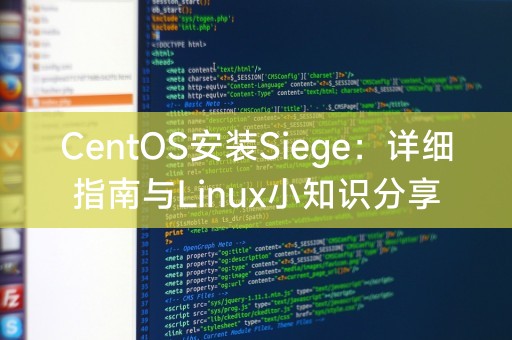
php editor Strawberry brings you a detailed guide on installing Siege on CentOS and shares some Linux knowledge. Siege is a tool for stress testing and load testing, often used to test the performance and stability of websites. This article will provide you with detailed steps to install Siege under CentOS system, and share some knowledge about Linux to help you better understand and use this powerful tool. Whether you are a beginner or a user with a certain Linux foundation, this article can provide you with practical guidance and knowledge sharing. Let’s get started!

To install Siege on CentOS, follow these steps:
1. Open Terminal and use the following Command to update the system package list:
```sql
sudo yum update
```
2. Install EPEL repository (Extra Packages for Enterprise Linux):
```arduino
sudo yum install epel-release
3. Install Siege:
sudo yum install siege
4. To verify whether Siege is installed successfully, you can run the following command to view version information:
```css
siege --version
If you see Siege version information, the installation is successful.
Linux is a multi-user, multi-tasking operating system with powerful functions and flexibility. The following is a Linux knowledge to help you better understand and Use this system:
1. Use the Tab key to automatically complete commands: When entering commands in the terminal, you can use the Tab key to automatically complete commands or file paths to improve input efficiency.
2. Use the history command (History): In the terminal, you can use the up and down arrow keys to review and re-execute the previously entered command, and you can also use "!!" to repeatedly execute the previous command.
3. Use wildcard characters (Wildcard): In Linux, you can use wildcard characters (such as "*" and "?") to match file names or directory names to facilitate file operations.
These little knowledge can help you use the Linux system more efficiently.
Share with you: When using a Linux system, understanding and mastering some basic command line skills can greatly improve your work efficiency. In addition to the little knowledge mentioned above, there are many other command line skills. It is worth learning. Use the "grep" command to filter output, use the "find" command to find files, use the "chmod" command to change file permissions, etc. Through continuous learning and practice, you will better master the use and management of Linux systems.
I hope this article can help you successfully install Siege on CentOS and share some useful Linux knowledge. If you have any questions or need further help, please feel free to contact us.
The above is the detailed content of Install Siege on CentOS: Detailed guide and Linux knowledge sharing. For more information, please follow other related articles on the PHP Chinese website!




